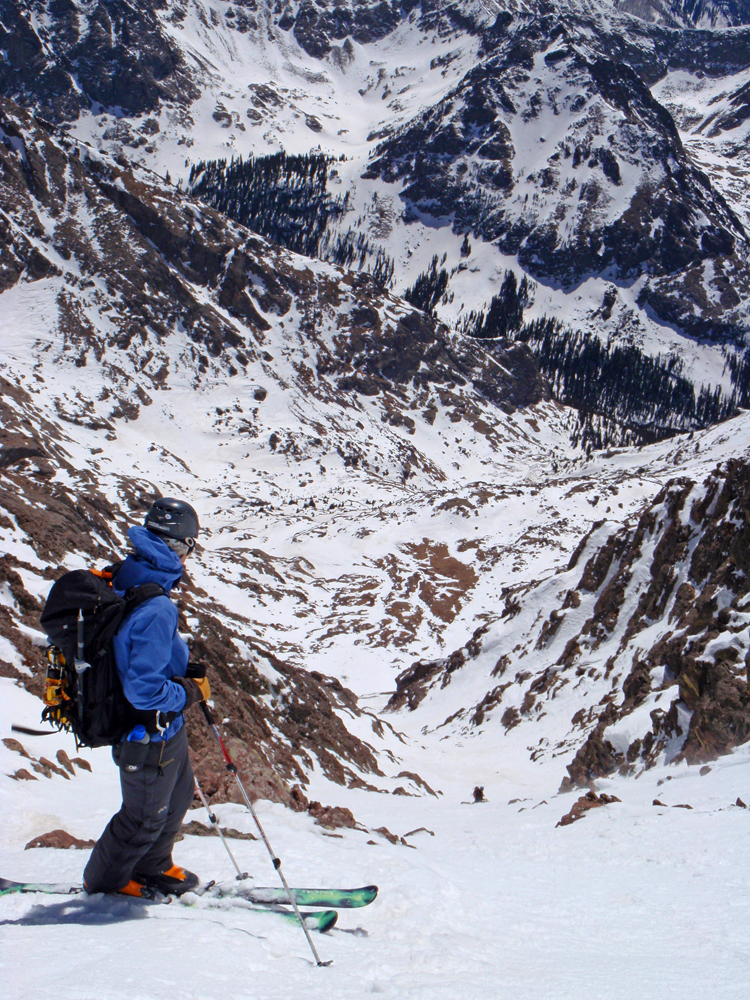Skiing & Boarding
Skiing 14ers in Winter
Almost always NO!
We have included the Skiing & Boarding section only as a reference to make clear when it's appropriate to ski a 14er and it's not in the winter months. In Colorado, 14ers and other high peaks can only be safely skied on stable, consolidated snow, in spring or early summer. Skiing a 14er in mid-winter could put you in DEADLY avalanche conditions.
Now, for a couple of possible exceptions. Some of the easier winter peaks, mentioned in the Starter Peaks section, can be safely skied in winter months if they have sufficient snow cover and avalanche danger is low. Quandary, Sherman and Grays have relatively easy access in winter and can be skied if you take the safest route. On Quandary, that means skipping the lower east bowl and sticking to the ridge on the descent. On Sherman, it's the South Slopes route as long as not too much snow-loading has occurred near the saddle between Sherman and 13er White Ridge. And on Grays, ski the standard route but be sure to stay away from the base of 13er Kelso Mountain on both your ascent and descent.

Are You Experienced?
A specific set of skills and gear are required to ski or ride in the backcountry. 14er ski routes can be steep, dangerous, and difficult. On many, a fall could be fatal. Skiing backcountry peaks is much different than visiting the ski area and the route difficulties should not be compared directly to ski area standards. A novice backcountry ski route does not mean that it is as easy as a green trail at the ski area - it means that the route is recommended for novice backcountry skiers. Novice and Intermediate trails at the ski area are often groomed and free of most obstacles.
14er and other high peak skiing is difficult. You're taking one run after a long ascent. There's no warm-up run and you're descending with a lot of gear on varying terrain. If conditions are good and you picked the right location, it can be fantastic. Conditions can vary greatly on a single line and it's rarely ever as smooth as a resort run. So, before you buy backcountry ski gear with the intention of hitting a 14er, make sure you've spent a lot of time at the resort getting good, really good. If you're an intermediate skier at the resort, you will suffer on a peak and may put yourself in real danger. Seriously, backcountry peaks are not the place to learn how to ski at an advanced level.
Equipment
For short trips, many people climb in ski or snowboard boots and just snap on equipment for the descent. This is ok for short trips but if you're serious about backcountry travel, it's good to get the right stuff. Ski touring equipment allows you to ski in, ascend slopes using skins, and ski down. Telemark equipment is used by many for backcountry travel and telemark ski descents. For the regular downhill skier, Alpine touring (AT) equipment gets you uphill with skins and touring bindings and descents are made by locking your heel into the binding.
For snowboarders, gear has advanced dramatically in recent years. Back in the day, boarders had wear snowshoes and carry their board up the peak. Now, splitboard style snowboards allow the rider to ascend the route with half of the board attached to each foot, with skins, just like skiers. For the descent, the board sections are reconnected, the binding repositioned and the descent can be made as usual.
Find Experienced Partners
Whether your attempting one of the "easy" 14ers in winter or your looking to get into spring peak skiing, find some experienced partners who have skied peaks in Colorado. You don't need to do this yourself. Post in the Climbing Connection of the 14ers.com forum or ask around on Facebook and you'll likely find other 14er skiers. There are plenty of us.


